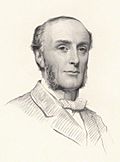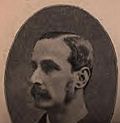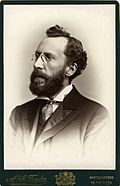Quick facts for kids {{{Name}}}
[[{{{Type}}} constituency]] |
[[Image:{{{Map1}}}Constituency.svg|120px|]]
[[Image:England{{{Map2}}}.svg|120px|]] |
| {{{Name}}} shown within [[{{{Entity}}}]], and {{{Entity}}} shown within England |
| Created: |
{{{Year}}} |
| MP: |
{{{MP}}} |
| Party: |
{{{Party}}} |
| Type: |
House of Commons |
| County: |
[[{{{County}}}]] |
| EP constituency: |
[[{{{EP}}} (European Parliament constituency)|{{{EP}}}]] |
Hampstead was a borough constituency, centered on the Hampstead area of North London. It returned one Member of Parliament (MP) to the House of Commons of the Parliament of the United Kingdom, who was elected using the first-past-the-post voting system.
It was created for the 1885 general election, and abolished for the 1983 general election, when it was partly replaced by the new Hampstead and Highgate constituency.

Hampstead in the Metropolitan area, boundaries used 1885-1918
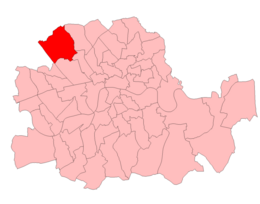
Hampstead in the Parliamentary County of London, boundaries used 1918-50
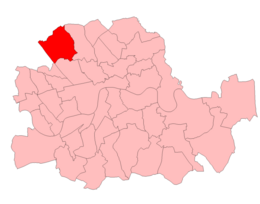
Hampstead in the Parliamentary County of London, boundaries used 1950-74
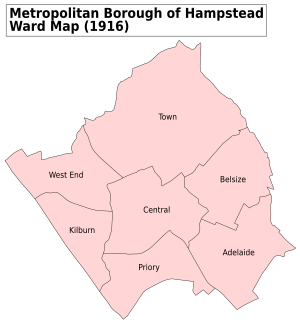
A map showing the wards of Hampstead Metropolitan Borough as they appeared in 1916.
Boundaries
1885–1918: The parish of St John, Hampstead.
The parliamentary borough of Hampstead was created by the Redistribution of Seats Act 1885, and consisted of the civil parish of St John, Hampstead, Middlesex. The parish had previously formed part of the Parliamentary County of Middlesex. Hampstead lay within the area of the Metropolitan Board of Works, and in 1889 this became the County of London. In 1900 the county was divided into twenty-eight metropolitan boroughs, with the civil parish becoming the Metropolitan Borough of Hampstead.
Parliamentary constituencies were redrawn under the Representation of the People Act 1918, with boundaries in London realigned to those of the metropolitan boroughs. Accordingly, the Hampstead constituency was defined by the legislation as being identical in area to the metropolitan borough of the same name. When the next redistribution was carried out under the Representation of the People Act 1948, the term "parliamentary borough" was replaced with "borough constituency". The renamed Hampstead Borough Constituency continued with the same boundaries, with the changes coming into effect for the 1950 general election.
In 1965 both the County of London and the metropolitan boroughs were abolished. Hampstead became part of the larger London Borough of Camden. The changes were not reflected in parliamentary boundaries until 1970. The constituency was officially renamed "Camden, Hampstead Borough Constituency" and was defined as comprising seven wards of the London Borough, namely Adelaide, Belsize, Hampstead Town, Kilburn, Priory, Swiss Cottage and West End. The wards of the borough were altered in 1973, with Swiss Cottage ward replacing Hampstead Central in the constituency's definition. These boundaries were used until 1983, when the seat was abolished.
Members of Parliament
Election results
Elections in the 1880s
Holland was appointed Vice-President of the Committee of the Council on Education, requiring a by-election.
Holland was elevated to the peerage, becoming Lord Knutsford, causing a by-election.
| By-election, 28 Feb 1888: Hampstead |
| Party |
Candidate |
Votes |
% |
±% |
|
Conservative |
Edward Brodie Hoare |
Unopposed |
|
Conservative hold |
Elections in the 1890s
Elections in the 1900s
Election in the 1910s
Elections in the 1920s
| General election 1922: Hampstead |
| Party |
Candidate |
Votes |
% |
±% |
|
Unionist |
George Balfour |
14,596 |
59.7 |
-11.1 |
|
National Liberal |
Albert Clavering |
5,582 |
22.9 |
New |
|
Liberal |
Lancelot Sackville Fletcher |
4,282 |
17.5 |
New |
| Majority |
9,014 |
36.8 |
-14.7 |
| Turnout |
24,460 |
63.1 |
+5.0 |
|
Unionist hold |
Swing |
N/A |
|
| General election 1923: Hampstead |
| Party |
Candidate |
Votes |
% |
±% |
|
Unionist |
George Balfour |
13,513 |
58.6 |
-1.1 |
|
Liberal |
Lancelot Sackville Fletcher |
9,538 |
41.4 |
+23.9 |
| Majority |
3,975 |
17.2 |
-19.6 |
| Turnout |
23,051 |
58.0 |
-5.1 |
|
Unionist hold |
Swing |
-1.1 |
|
| General election 1924: Hampstead |
| Party |
Candidate |
Votes |
% |
±% |
|
Unionist |
George Balfour |
21,432 |
79.1 |
+20.5 |
|
Labour |
Charles Terry Hendin |
5,662 |
20.9 |
New |
| Majority |
15,770 |
58.2 |
+41.0 |
| Turnout |
27,094 |
67.2 |
+9.2 |
|
Unionist hold |
Swing |
N/A |
|
| General election 1929: Hampstead |
| Party |
Candidate |
Votes |
% |
±% |
|
Unionist |
George Balfour |
23,370 |
58.3 |
-20.8 |
|
Labour |
F. E. Dawkins |
8,473 |
21.1 |
+0.2 |
|
Liberal |
M. Leon Freedman |
8,273 |
20.6 |
New |
| Majority |
14,897 |
37.1 |
-21.1 |
| Turnout |
40,116 |
62.8 |
-4.4 |
|
Unionist hold |
Swing |
-10.5 |
|
Elections in the 1930s
| General election 1931: Hampstead |
| Party |
Candidate |
Votes |
% |
±% |
|
Conservative |
George Balfour |
36,928 |
87.1 |
+28.8 |
|
Labour |
Harry Smith |
5,475 |
12.9 |
-8.2 |
| Majority |
31,453 |
74.2 |
+37.1 |
| Turnout |
42,403 |
77.8 |
+15.0 |
|
Conservative hold |
Swing |
+18.5 |
|
| General election 1935: Hampstead |
| Party |
Candidate |
Votes |
% |
±% |
|
Conservative |
George Balfour |
28,334 |
73.2 |
-13.9 |
|
Labour |
Harry Smith |
6,987 |
18.0 |
+5.1 |
|
Liberal |
John L. Young |
3,396 |
8.8 |
New |
| Majority |
21,347 |
55.2 |
-19.0 |
| Turnout |
38,717 |
59.0 |
-18.8 |
|
Conservative hold |
Swing |
|
|
Elections in the 1940s
| 1941 Hampstead by-election |
| Party |
Candidate |
Votes |
% |
±% |
|
Conservative |
Charles Challen |
7,630 |
67.4 |
-5.8 |
|
National |
Noel Pemberton Billing |
2,734 |
24.1 |
New |
|
Independent Progressive |
Reg Hipwell |
636 |
5.6 |
New |
|
Independent |
Arthur L. Dolland |
326 |
2.9 |
New |
| Majority |
4,896 |
43.3 |
N/A |
| Turnout |
11,326 |
17.3 |
-41.7 |
|
Conservative hold |
Swing |
N/A |
|
| General election 1945: Hampstead |
| Party |
Candidate |
Votes |
% |
±% |
|
Conservative |
Charles Challen |
19,652 |
51.8 |
-20.4 |
|
Labour |
William Field |
18,294 |
48.2 |
+30.2 |
| Majority |
1,358 |
3.6 |
-51.6 |
| Turnout |
37,946 |
68.4 |
+9.4 |
|
Conservative hold |
Swing |
N/A |
|
Elections in the 1950s
| General election 1951: Hampstead |
| Party |
Candidate |
Votes |
% |
±% |
|
Conservative |
Henry Brooke |
31,346 |
55.1 |
+2.8 |
|
Labour |
Arthur Richardson |
19,240 |
33.8 |
+3.5 |
|
Liberal |
Wilfred Sydney Watson |
6,320 |
11.1 |
-3.5 |
| Majority |
12,106 |
21.3 |
-0.7 |
| Turnout |
56,906 |
|
|
|
Conservative hold |
Swing |
-0.3 |
|
| General election 1955: Hampstead |
| Party |
Candidate |
Votes |
% |
±% |
|
Conservative |
Henry Brooke |
28,226 |
55.9 |
+0.8 |
|
Labour |
Arthur Richardson |
16,040 |
31.8 |
-2.0 |
|
Liberal |
Harry Charles Seigal |
6,222 |
12.3 |
+1.2 |
| Majority |
12,186 |
24.1 |
+2.8 |
| Turnout |
50,488 |
|
|
|
Conservative hold |
Swing |
+1.4 |
|
| General election 1959: Hampstead |
| Party |
Candidate |
Votes |
% |
±% |
|
Conservative |
Henry Brooke |
25,506 |
53.4 |
-2.5 |
|
Labour |
David Pitt |
13,500 |
28.3 |
-3.5 |
|
Liberal |
Harry Charles Seigal |
8,759 |
18.3 |
+6.0 |
| Majority |
12,006 |
25.1 |
+1.0 |
| Turnout |
47,765 |
|
|
|
Conservative hold |
Swing |
+0.5 |
|
Elections in the 1960s
| General election 1964: Hampstead |
| Party |
Candidate |
Votes |
% |
±% |
|
Conservative |
Henry Brooke |
19,888 |
43.3 |
-10.1 |
|
Labour |
John W T Cooper |
18,053 |
39.3 |
+11.0 |
|
Liberal |
Renee Soskin |
8,019 |
17.4 |
-0.9 |
| Majority |
1,835 |
4.0 |
-21.1 |
| Turnout |
45,960 |
67.6 |
|
|
Conservative hold |
Swing |
-10.5 |
|
| General election 1966: Hampstead |
| Party |
Candidate |
Votes |
% |
±% |
|
Labour |
Benjamin Whitaker |
22,963 |
46.8 |
+7.5 |
|
Conservative |
Henry Brooke |
20,710 |
42.2 |
-1.1 |
|
Liberal |
Renee Soskin |
5,182 |
10.7 |
-6.7 |
|
Socialist (GB) |
Harry Baldwin |
211 |
0.4 |
New |
| Majority |
2,253 |
4.6 |
N/A |
| Turnout |
49,066 |
72.4 |
+4.8 |
|
Labour gain from Conservative |
Swing |
+4.3 |
|
Elections in the 1970s







